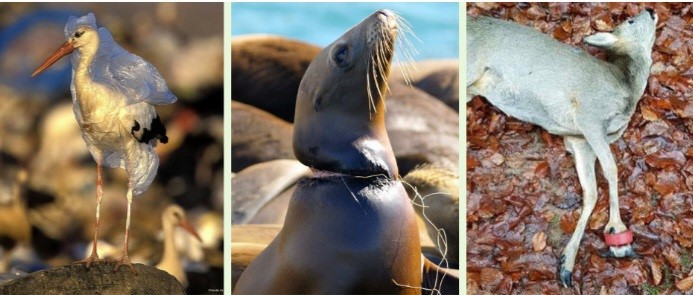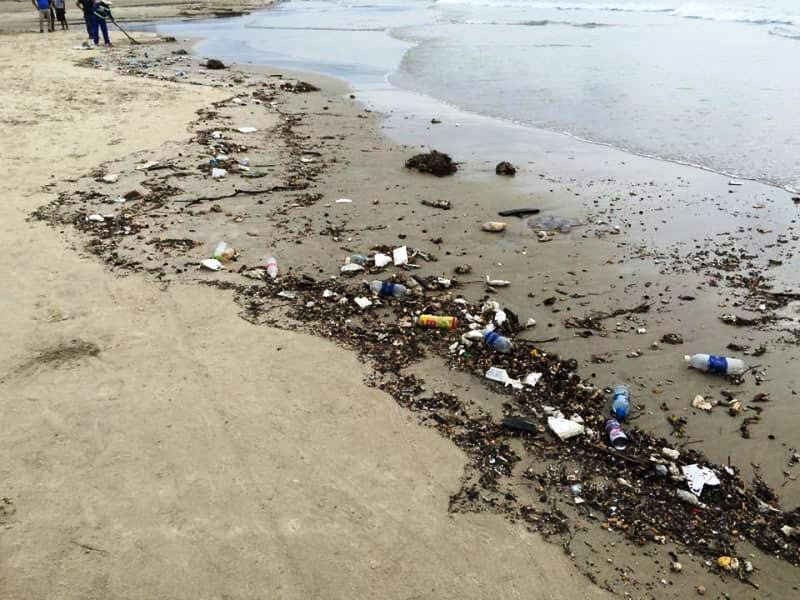1. The Current Status of Improper Waste Disposal
In coastal areas, tourist sites, and biosphere reserves, waste such as plastic, metal, glass, and paper is often discarded carelessly, causing environmental issues for local areas and negatively impacting the living environment of organisms and ecosystems.

Figure 1. Plastic waste collected during a monitoring session at Minh Chau beach, Bai Tu Long National Park [1]
According to a study by the Tourism Development Research Institute – General Department of Tourism, the average growth rate of tourists to Bai Tu Long Bay has significantly increased in recent years, leading to a higher demand for services, fishing, accommodations, and boating activities. Consequently, the amount of waste released into the natural environment of Bai Tu Long Bay has also increased. The main components of this waste include candy wrappers, plastic bottles, plastic bags, and glass bottles. According to statistics from the International Union for Conservation of Nature (IUCN), plastic waste accounts for 60-80% of the waste collected in the marine and island areas of Bai Tu Long National Park. Increasing environmental pollution and the generation of more waste, coupled with improper disposal, have led to adverse effects on the lives of natural organisms and ecosystems [1].
2. What are the impacts of improper waste disposal on ecosystems ?

Figure 2. The detrimental effects of improper waste disposal on living organisms [2]
According to experts, the physical impact of plastic waste on the environment leads to the destruction or degradation of biodiversity, causing the death of organisms due to entanglement in lost or discarded fishing nets or ingestion. Floating plastic fragments also increase the risk of invasive species affecting ecosystems. Particularly, plastic waste in water environments breaks down into microplastics over time, directly impacting the environment. Some studies have shown that the accumulation of microplastics in organisms can pose health risks, such as reduced food intake, increased oxidative stress, and damage to digestive organs. Moreover, organisms can be poisoned by additives used in plastic production or other toxic substances absorbed on the surface of microplastics during their persistence and spread in the environment, including persistent organic pollutants and heavy metals.
Improper waste disposal causes serious harm to protected areas and national parks, threatening the existence of many rare and precious plant and animal species, reducing biodiversity, and potentially diminishing the conservation and tourism value of these areas, leading to significant environmental and economic losses.
Plastic waste, with a decomposition time of hundreds of years, is one of the most prevalent and impactful waste components. When plastic waste like bags, bottles, and packaging is discarded carelessly, it can be swept into river systems and spread to protected areas. Wildlife in these reserves, such as birds and turtles, often mistake plastic waste for food, leading to digestive blockages, malnutrition, reduced reproductive capabilities, and even death. Sea turtles and fish are also prone to becoming entangled in plastic debris, causing severe health damage and reducing animal populations.
Not only plastic but also metal and glass waste poses significant risks. When metal rusts or glass breaks, they can cause serious injuries to animals and even humans if not detected and handled promptly.

Figure 3. Da Nang beach attacked by Plastic waste [4]
3. What can we do to protect our environment?
To mitigate this situation, the community needs to act together. Raising public awareness through educational and propaganda programs about the harmful effects of waste is essential. Sorting waste at the source and encouraging recycling are also important measures. The community should actively participate in beach clean-up campaigns, parks, public areas, as well as in reserves and national parks, to protect our living environment.
Participate in short courses to gain more environmental knowledge. The course “Views and Values of Nature” involves practical environmental protection activities. Participants will have the opportunity to experience tree planting, garbage collection in public areas, and engage in environmental protection projects. These activities not only help learners apply acquired knowledge into practice but also provide opportunities to connect with the community, contributing to building a greener and more sustainable living environment.
For more information about the course, visit HERE
Register early to join us HERE
References
- Dao Thu Thuy (June 30, 2022) Bai Tu Long National Park Management Board organized the first beach plastic waste monitoring program in 2022
- Sai Canh. (January 6, 2023). The harmful effects of plastic waste on living organisms. Wingpad
- Hoa BT (August 22, 2023). The impact of plastic waste on marine and coastal ecosystems. Thanh Hoa Newspaper
- Giamracnhua. (November 15, 2022). Ministry of Natural Resources and Environment reports on the national marine environmental status. Reducing Ocean Plastic Waste in Vietnam.
- Nhi Anh. (February 28, 2024). Vietnam releases 1.8 million tons of plastic waste into the environment annually. Economic Life of Vietnam & the World
- Baotainguyenmoitruong.Vn. (June 16, 2018). Da Nang: Protecting the sea from plastic waste pollution. baotainguyenmoitruong.vn


 Tiếng Việt
Tiếng Việt 日本語
日本語